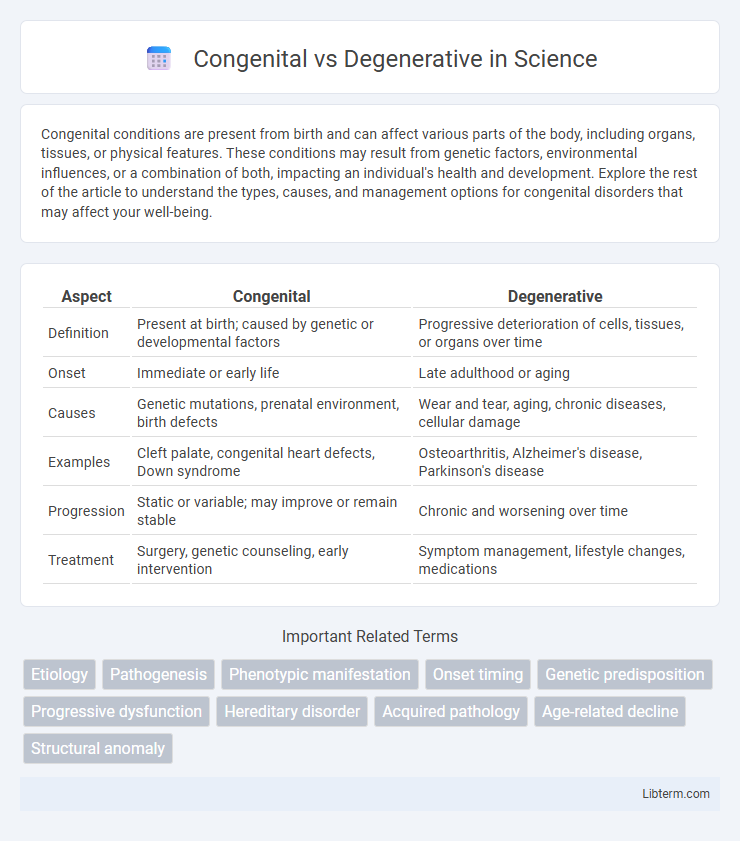Congenital conditions are present from birth and can affect various parts of the body, including organs, tissues, or physical features. These conditions may result from genetic factors, environmental influences, or a combination of both, impacting an individual's health and development. Explore the rest of the article to understand the types, causes, and management options for congenital disorders that may affect your well-being.
Table of Comparison
| Aspect | Congenital | Degenerative |
|---|---|---|
| Definition | Present at birth; caused by genetic or developmental factors | Progressive deterioration of cells, tissues, or organs over time |
| Onset | Immediate or early life | Late adulthood or aging |
| Causes | Genetic mutations, prenatal environment, birth defects | Wear and tear, aging, chronic diseases, cellular damage |
| Examples | Cleft palate, congenital heart defects, Down syndrome | Osteoarthritis, Alzheimer's disease, Parkinson's disease |
| Progression | Static or variable; may improve or remain stable | Chronic and worsening over time |
| Treatment | Surgery, genetic counseling, early intervention | Symptom management, lifestyle changes, medications |
Introduction to Congenital vs Degenerative Conditions
Congenital conditions are present at birth, resulting from genetic or environmental factors during fetal development, while degenerative conditions develop over time due to aging, wear, or disease progression. Common congenital disorders include heart defects and cystic fibrosis, whereas degenerative diseases often involve osteoarthritis, Alzheimer's, and Parkinson's disease. Understanding the distinct origins and progression patterns of congenital versus degenerative conditions is crucial for accurate diagnosis, treatment planning, and patient care.
Defining Congenital Disorders
Congenital disorders are medical conditions present from birth, resulting from genetic abnormalities, environmental factors, or developmental issues during pregnancy. These disorders can affect the structure or function of various body parts, leading to physical or cognitive disabilities. Unlike degenerative conditions, which worsen over time due to aging or disease processes, congenital disorders manifest early and may require lifelong management.
Understanding Degenerative Diseases
Degenerative diseases involve the progressive deterioration of cells, tissues, or organs, often impacting the nervous system, joints, or muscles, and typically manifest later in life. Common examples include Alzheimer's disease, Parkinson's disease, and osteoarthritis, characterized by the gradual loss of function and structure over time. Understanding degenerative diseases requires examining genetic predispositions, environmental factors, and cellular mechanisms like protein misfolding and inflammation that contribute to their development.
Key Differences Between Congenital and Degenerative
Congenital conditions are present at birth and typically result from genetic factors or developmental issues during pregnancy, whereas degenerative conditions develop over time due to aging, wear and tear, or disease progression. Key differences include onset timing, with congenital disorders manifesting early in life and degenerative disorders occurring later, often worsening gradually. Treatment approaches also vary, as congenital issues may require early intervention or surgery, while degenerative diseases often focus on slowing progression and managing symptoms.
Common Examples of Congenital Conditions
Common examples of congenital conditions include heart defects such as ventricular septal defect and atrial septal defect, as well as neural tube defects like spina bifida and anencephaly. These disorders are present at birth, often caused by genetic factors or environmental influences during fetal development. In contrast, degenerative conditions, including osteoarthritis and Alzheimer's disease, develop gradually over time due to aging or wear and tear on the body.
Typical Degenerative Diseases Overview
Degenerative diseases primarily affect older adults and result from the progressive deterioration of tissues or organs, with common examples including Alzheimer's disease, Parkinson's disease, and osteoarthritis. These conditions typically involve the gradual loss of function due to cellular damage, inflammation, or genetic factors exacerbated by aging. Unlike congenital disorders present at birth due to genetic or developmental anomalies, degenerative diseases develop over time and severely impact quality of life through progressive disability.
Causes and Risk Factors
Congenital conditions arise from genetic mutations, developmental anomalies, or prenatal environmental exposures, while degenerative disorders result from age-related wear, chronic inflammation, or metabolic imbalances. Genetic predisposition, maternal health, and in utero exposures increase the risk of congenital abnormalities, whereas aging, lifestyle factors, and chronic diseases such as diabetes or osteoarthritis elevate the risk of degenerative conditions. Understanding these distinct causes and risk profiles is essential for targeted prevention and treatment strategies.
Diagnosis and Detection Methods
Diagnosis of congenital conditions primarily involves prenatal imaging techniques such as ultrasound and fetal MRI, alongside genetic testing to detect inherited abnormalities early. Degenerative diseases are commonly identified through clinical evaluation, MRI, CT scans, and biomarker analysis to assess progressive tissue damage over time. Advanced diagnostic tools including electrophysiological studies and molecular assays improve detection accuracy for both congenital malformations and degenerative pathologies.
Treatment Options and Management
Treatment options for congenital disorders often involve surgical interventions and physical therapy tailored to the specific anomaly, aiming to correct or manage symptoms early in life. Degenerative conditions require a combination of medication to slow progression, physical rehabilitation to maintain function, and sometimes surgical procedures such as joint replacement or spinal decompression. Management strategies emphasize multidisciplinary care, including pain control, lifestyle modifications, and regular monitoring to optimize patient quality of life.
Prognosis and Long-term Outcomes
Congenital conditions often present with structural abnormalities diagnosable at birth, with prognosis varying widely based on severity and early intervention, while degenerative diseases progressively worsen over time, frequently leading to chronic disability. Long-term outcomes for congenital disorders can improve significantly with timely surgical or therapeutic management, whereas degenerative conditions typically require ongoing symptom management and may lead to gradual functional decline. Both types demand tailored treatment plans to optimize quality of life and delay progression.
Congenital Infographic

 libterm.com
libterm.com